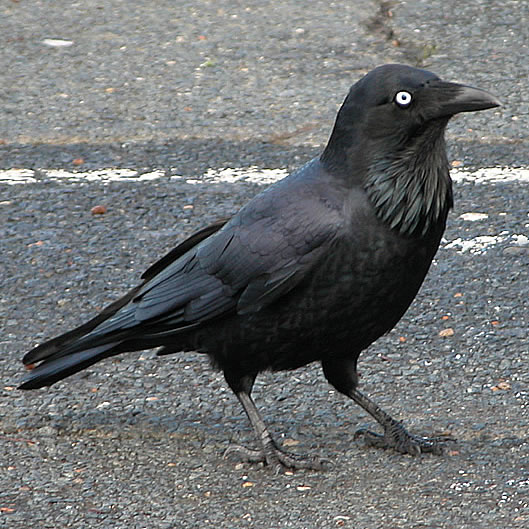|
| Query: Torresian crow | Result: 14th of 14 | |
Australian Raven (Corvus coronoides) - Wiki
| Subject: | Australian Raven (Corvus coronoides) - Wiki
| |

| Resolution: 529x529
File Size: 100863 Bytes
Upload Date: 2007:12:02 20:27:10
|
Australian Raven
From Wikipedia, the free encyclopedia
Order: Passeriformes
Family: Corvidae
[Photo] Australian Raven (Corvus coronoides). Date 2005. Author Brett Donald
The Australian Raven (Corvus coronoides) is the largest member of the genus Corvus and one of three commonly known as ravens in Australia. It is a more slender bird than the Common Raven of the Northern Hemisphere but is otherwise similar.
Like the other Corvus members in Australia and some species from the islands to the north, it has a white iris.
Taxonomy and naming
The Australian Raven was first described by Nicholas Aylward Vigors and Thomas Horsfield in 1827;its specific epithet coronoides "crow-shaped" is derived from the Greek corone/κορονη "crow" and eidos/ειδο?? "shape" or "form".
Though called a raven, its closest affinities lie with the other four species of Australian corvid, which include the Torresian Crow and Little Crow as well as the Forest Raven and Little Raven.
Description
At 52 cm (20 in) in length, the adult Australian Raven is an all black bird with black feet and beak and a white iris. Its throat feathers (hackles) are longer than those of other species. It can be distinguished from the two species of crow occurring in Australia by the grey base of the feathers, which is white in the latter species. Juveniles resemble adults, but have dark eyes, shorter throat hackles, and sometimes have a pink fleshy gape.
The territorial call of the Australian Raven is a slow, high ah-ah-ah-aaaah with the last note drawn out.
Distribution and habitat
The Australian Raven is common throughout eastern, southern Australia and southern Western Australia (the populations being connected by a narrow strip across the Nullarbor Plain) but not found in the far north. It has adapted very well to human habitation in some cities and is a common bird in urban Sydney, and Rottnest Island.
Behaviour
The Australian Raven is known to be very timid flinching at the first sight of humans and usually fly away if looked in the eye for too long (about ten seconds). In rural areas a single breeding pair and their brood will occupy about a square kilometre territory, whilst in urban areas over ten times more ravens can search for food in the same square kilometre.
Diet
Food consists of carrion, insects, seeds, fruit, small reptiles, nestlings and eggs. The preference ratio is 34% carrion, 42% invertebrates and 24% plant material. Food is taken mainly from the ground but will occasionally feed in trees. Ravens have adapted well to eating rubbish and scraps in urban areas, such as school playgrounds. In one isolated study they were observed feeding on nectar from eucalypt flowers.
Reproduction
Breeding season is from July to September. Ravens always nest in tall trees, never near to the ground as some species do. Nests are generally large and untidy, consisting of a bowl or platform of sticks lined with grasses, barks, and feathers. A clutch can comprise 3-6 eggs, though usually 4 or 5 are laid. Measuring 45 mm x 30 mm (1¾ in x 1¼ in), eggs are pale green or bluish-green splotched with darker olive, brown and blackish markings. Incubation of the eggs is done solely by the female over roughly 20 days. Only one brood is raised per year. Fledged by 45 days and staying with parents for about four months after that.
Relationship with Humans
The Australian Raven is frequently blamed for the loss of young lambs or kids. Scientific observation in the country's southeast showed that the killing of healthy lambs was rare but that sick animals were predisposed to being attacked.
http://en.wikipedia.org/wiki/Australian_Raven
| The text in this page is based on the copyrighted Wikipedia article shown in above URL. It is used under the GNU Free Documentation License. You may redistribute it, verbatim or modified, providing that you comply with the terms of the GFDL. |
|
Comments |
|---|
| | Guest |
|
your info was kool.
i think you should put put in that the crow is bigger |
^o^
Animal Pictures Archive for smart phones
^o^
|
|
|